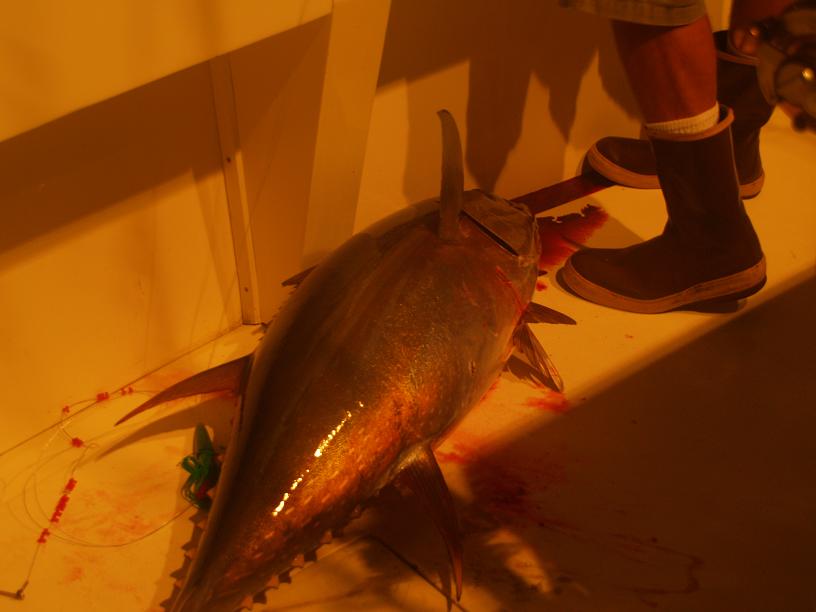NJ Saltwater Fishing Articles
- Details
- Category: Fishing Articles
- Published: Friday, 26 September 2008 03:31
- Hits: 52009
 First off you need to get the baits down deeper to where the fish are. Without lines set to the proper depths you are wasting your time on beginning the chunk. Looking at the fishfinder are you marking any fish down deep? Do you have the fishfinder set to show the depths of the targets? If not get out your manual if you don?t know how to turn that feature on and turn on target depths. If you are marking fish at a particular depth you want to get some lines down to that depth with 1 just above it and another just below it to give yourself a good spread of baits.
First off you need to get the baits down deeper to where the fish are. Without lines set to the proper depths you are wasting your time on beginning the chunk. Looking at the fishfinder are you marking any fish down deep? Do you have the fishfinder set to show the depths of the targets? If not get out your manual if you don?t know how to turn that feature on and turn on target depths. If you are marking fish at a particular depth you want to get some lines down to that depth with 1 just above it and another just below it to give yourself a good spread of baits.We typically on the overnight fish 5-6 lines at a maximum. One line we set up for swords and send down deep (like 150-200 feet). To determine how deep to send the swordfish line you need to find the thermocline on your fish finder and then send the bait a good 25-50 feet below that level.
For tuna, we will send 1 line down 50 feet, one at 60; 1 at 70 feet and one tight to the boat at perhaps 30 feet (and about 25 feet away from the boat). As you throw the chunks and they drift down towards your lines and create the slick; they intermingle with the baited hooks. The idea is to have the tuna come along and enjoy the feast eventually to find your line.
How the heck do you get the lines down that deep you may wonder? For the swords it depends on the current. Last trip we used a 3lb weight. Other times we have used a 24 oz and as much as 4 lbs... you don't want to reeling that in too often. For the tuna, again depending on current up to 20 Oz's...
Most times we'll start with 8 and progress upwards if we see the need. We'll pull the line by 1 foot increments and see how fast it's dropping... typically we try and get it to go down at no more than a 30 degree angle from the boat. Once we get it to the proper depth we'll take a glow stick and stick it into a balloon then attach to the line with a rubber band. Then we'll pull more line to get it various distances from the boat. The glow stick will help you keep track of the balloons/lines to make sure they aren't crossing. It's the only reason we use them, others from what I hear don't use balloons at all, I like to keep a close eye on them though...
When you chunk, you cut up butterfish and throw 3-4 pieces in the water. As soon as the chunks disappear from view in the spreader lights you throw in 3-4 more pieces. You want to make sure you disperse the chunks so that they drift down toward your lines. Disperse the occasional anchovy (sardine) into the mix to give them an alternative choice.
The most important thing you can do is to post a person on the fishfinder at all times to mark the depth of the fish. If you see large red and yellow marks at 85 feet and have no lines at that depth; your odds are greatly decreased. You need to adjust your lines as you mark the fish. Many times just the adjustment of the lines can be enough to draw the attention of the tuna towards the bait. When you see the marks get your baits moving, but slowly.
Tuna traps, from the Tournament Cable Co.
 Tuna have incredible eyesight. If you see their presence but can't get a bite you need to make an adjustment to your leader strength. Many times you may start with 80lb test, and then find you need to drop it to 60, 50 or sometimes even 40 lb test to entice the bite and make the lines invisible. If you think the tuna may be ?line shy" you can use a tuna trap and bring the leader strength down to 40 or 30 lb test. A tuna trap is a hook "hidden" inside a butterfish with the lightest of leader protruding.
Tuna have incredible eyesight. If you see their presence but can't get a bite you need to make an adjustment to your leader strength. Many times you may start with 80lb test, and then find you need to drop it to 60, 50 or sometimes even 40 lb test to entice the bite and make the lines invisible. If you think the tuna may be ?line shy" you can use a tuna trap and bring the leader strength down to 40 or 30 lb test. A tuna trap is a hook "hidden" inside a butterfish with the lightest of leader protruding.
Normally this would snap due to the weakness of the line. However the trap releases a cable typically 110-130 lb wire strand that isn't "triggered" until the tuna swallows the butterfish. The leader pulls on the trap (basically a lightweight rubber band around the hook and cable hidden in the butterfish). These are available from fisherman?s supply or direct from the manufacturer on line.
Comments or Questions
Coming Next? How to determine ?Hot Spots?







